Last week my daughter donned a laurel wreath with a violet ribbon running through it and grinned from ear to ear as her friends chanted “Dott-O-Ray, Dott-O- Ray” – followed by some silly, lewd phrases that are not repeatable. It is all part of the university graduation tradition in Italy.
To graduate from an Italian university a student must complete a final thesis, and in a simple ceremony a committee presents them with the final grade and their “Laurea” or degree. With that degree, a Bachelor of Arts, the student earns the title “Dr.” or Dottore, or Dottoressa, hence the chant.
The friends provide the laurel wreath – considered a symbol of success and achievement. The color of the ribbon indicates the field of study. Violet is political science at Padua.
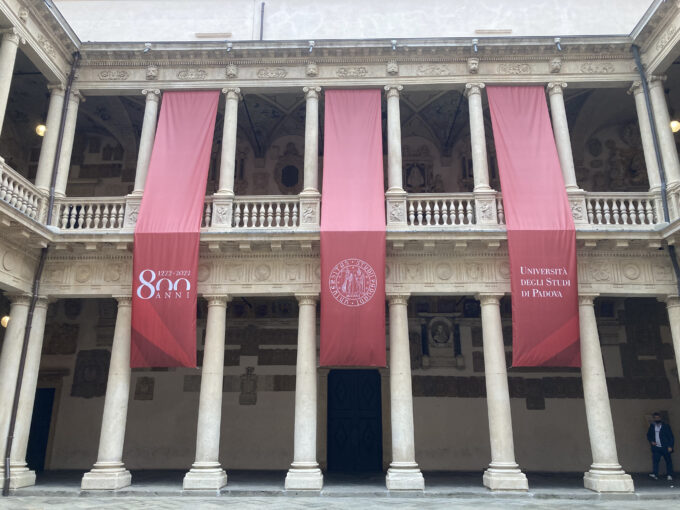
The University of Padua was founded – get this – in 1222 by the Venetian Republic and is about to celebrate its 800th year in 2022. For comparison’s sake, Harvard was founded in 1636. Among their many illustrious professors was Galileo Galilei, who was a professor of mathematics for 18 years at the University of Padua from 1592 to 1610. To put it into perspective, Galilieo Galilei was teaching students in Padua about the earth’s rotations before the pilgrims stepped out on Plymouth rock.
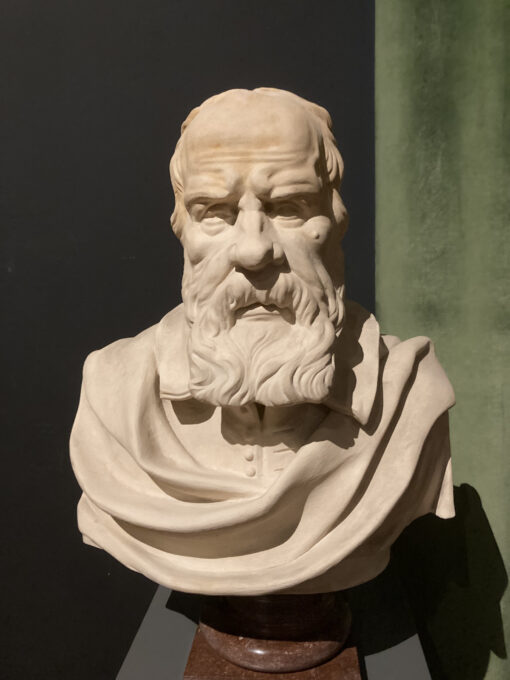
The University holds the distinction of having the first woman in the history of the world to graduate from a university. Elena Lucrezia Cornaro Piscopia graduated in philosophy in 1678. There is a statue of her in the Palazzo Bo – the first building of the university. Its name is short for a Latin word “bovis” meaning “cow” because the building was originally an inn in the butcher’s district of Padua.
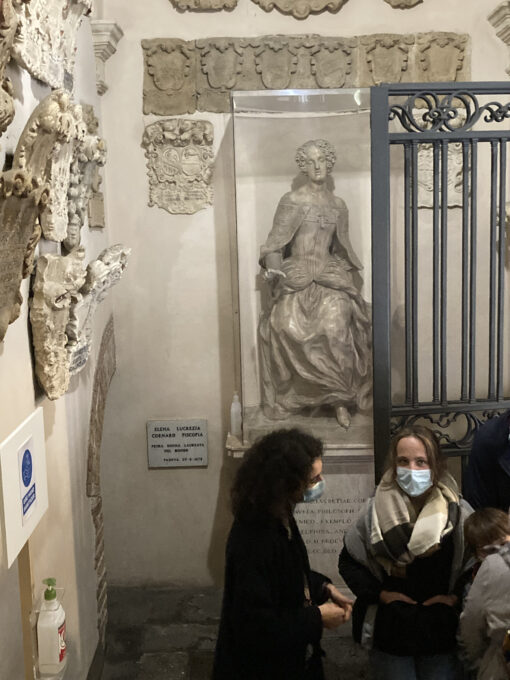
Palazzo Bo also holds the world’s first anatomical theater, an extraordinary structure that seems like a mini wooden colosseum, where professors of anatomy dissected two bodies a year in front of their students.
The anatomical theater is built with steep sides where medical students would stand leaning against wooden slats to watch the dissection below. The area where the professors were dissecting the body was lit with candles. There was no ventilation in the room and the students often fainted. I wonder if the professors wore masks or cloths over their faces to be able to work with the stench.
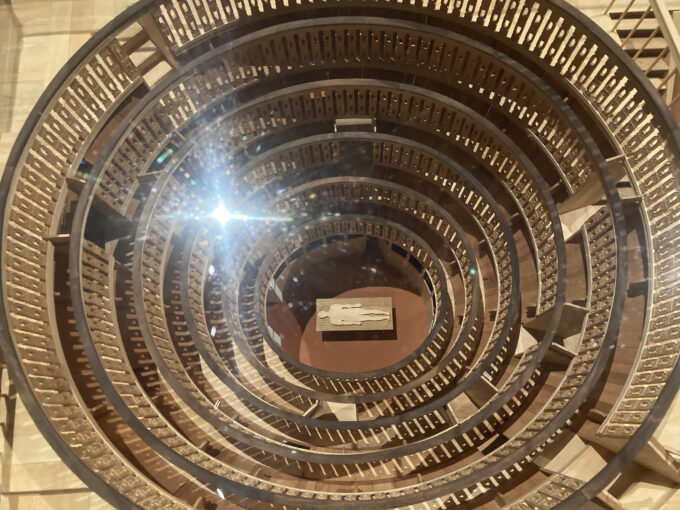
Among the interesting discoveries made in this theater were the Fallopian tubes, named after the University of Padua Professor of Anatomy, Gabriele Fallopio. And, not only that, he also apparently developed the precursor to the modern condom, soaking linen penis mitts in an herbal mixture that would prevent the wearer from contracting sexual diseases. He claimed to have provided 1,000 soldiers with his mitts and none of them got syphilis. Not sure how he confirmed that.
The corpses – one male and one female – were provided by the Republic of Venice and chosen from among the prisoners who had been executed. Once the dissection was completed the bodies were boiled in a nearby “kitchen” and then the bones put back together and shown to the students before being given to the church for burial which the students had to pay for.
After the tour of the Palazzo Bo’, my mother, a former university professor who revels in all things academic and marveled at the university, traipsed across the town’s cobblestones with me to the nearby Basilica of Saint Anthony where body parts are viewed in a very different light. The Basilica is an official Shrine to the Saint recognized by the Holy See, and as we approached, I could see the tell-tale signs of a pilgrimage site – the trinket stands lining the street outside with kitsch objects on sale with the Saint’s image.
Saint Anthony was a Franciscan Friar who lived in the 13th century and gained a reputation for his charisma, brilliant preaching and evangelizing. In addition to the exceptional structure with its spherical domes, courtyards and art in the Basilica, the pilgrims line up to leave photos of loved ones, prayers, and donations beside the tomb of the Saint and then file through the Chapel of the Relics. The chapel has floor to ceiling glass cabinets filled with gold-encased reliquaries holding 24 different relics, or body parts, of the saint.
According to a pamphlet in the Basilica, St. Anthony was buried in 1231 and in 1263, 32 years later, “when the coffin was opened the tongue was found incorrupt and then removed.” It is now the centerpiece of the Chapel along with his jawbone, and vocal apparatus.
After inching forward in the line to catch a glimpse of the tongue, my mother peered at the black item and shrugged, totally unimpressed. “Is that really his tongue? Why on earth would they bother to cut it out?” As I said, she is a former university professor and a unitarian.
I cannot complete my Padua post without a brief mention of the Scrovegni Chapel with the Giotto Frescoes. In case anyone else is as ignorant as I am when it comes to art history, the Giotto Frescoes on the walls of the Scrovegni Chapel are considered revolutionary and possibly the most seminal works in the history of western art for his use of perspective, emotion and color. According to one of my favorite historians, Ernst Gombrich, Giotto was a genius who “broke the spell of Byzantine conservatism” and altered medieval techniques ushering in Italy’s Renaissance and paving the way for the likes of Leonardo Da Vinci, Michelangelo and Raphael. Giotto “changed the whole conception of painting,” according to Gombrich.
To maintain the correct temperature in the chapel to avoid damage to the frescoes, visitors must first see a short film in an acclimatized room before being allowed fifteen minutes in the chapel. It is hard to absorb the greatness and the detail in just 15 minutes. Among the items that I made sure I saw were the first kiss in western art between Joachim and Anne, the grandparents of Jesus Christ.
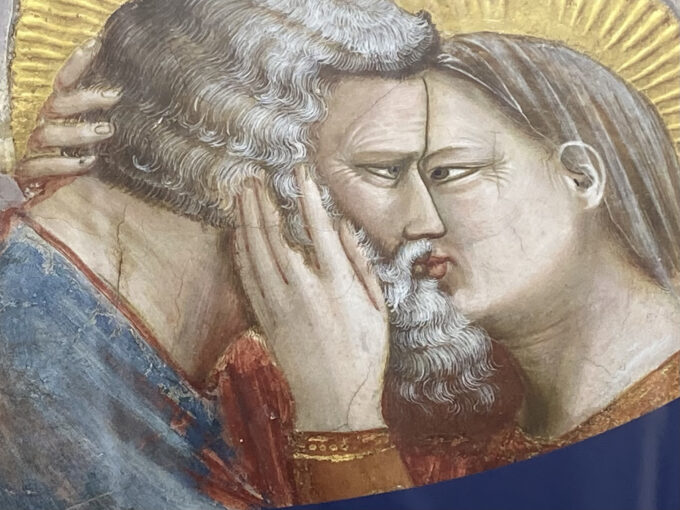
A contemporary of Dante, Giotto created a horrifying depictions of the inferno in “The Last Judgment” with a hairy, horned figure with one naked human figure half swallowed and one naked human figure grasped by the leg in each hand.
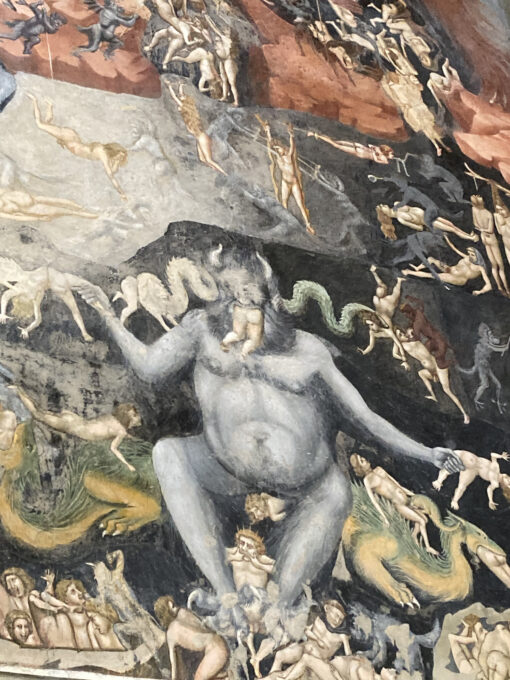
I admit that when my daughter first decided to study at the University of Padua, it was a decision she had come to with the help of her father, an Italian University professor. I wanted her to go to an English-language college or university. In retrospect, I cannot think of a better place than Padua.
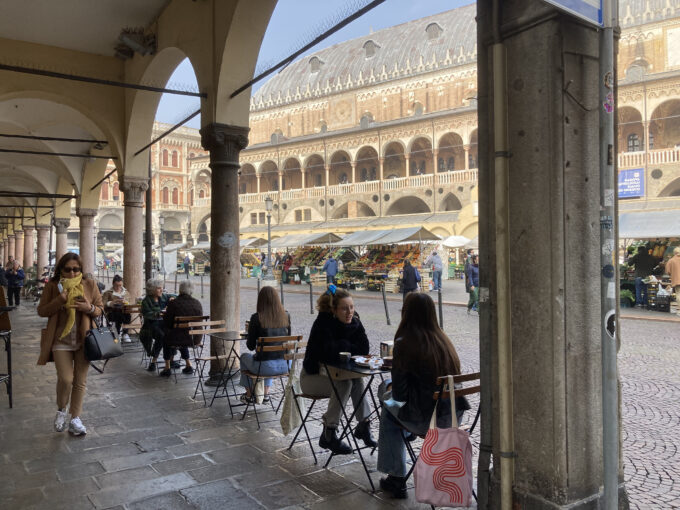

Really good to have you back with interesting stuff – best to you and your family.
Thank you, A|an. I have been missing the blogsphere.
Congratulations to Chiara. What a lovely event. May she enjoy many successes in the future.
Thank you, Jeanne, I think Chiara is feeling a bit unsure about the next steps… fairly normal. She will find her way.
Great information, details. Love the perspective.
Thanks
Kathryn
Great to hear from you Kathryn. Thanks for continuing to read my blog after all this time.
So glad to be reading your posts!
Thank you Joan. I am grateful to have such loyal readers.
Best wishes to your Daughter! I was surprised at the years that have flown by since I first found your blog and read about your young children. Now, you have a college graduate.
As always, I love the facts and interesting information you add to your posts.
The frost is on the pumpkins in Massachusetts!
Be well.
Thank you! It really is incredible to think that I have been writing about my children all these years and now they are all grown up! Frost on the pumpkins, wow! I miss New England in the fall.
Speaking of pumpkins, I did not mention that at a dinner after the graduation we had a scrumptious pumpkin and mushroom risotto. Absolutely delicious.
Thank you for sharing this wonderful milestone with Chiara! Congratultions to Chiara for all of her hardwork to earn her degree! Love from PA!
Cyndy
Thank you, Cyndy. I wish you could have been there with us.
The photos and history are fascinating! We must get to Italy one day!